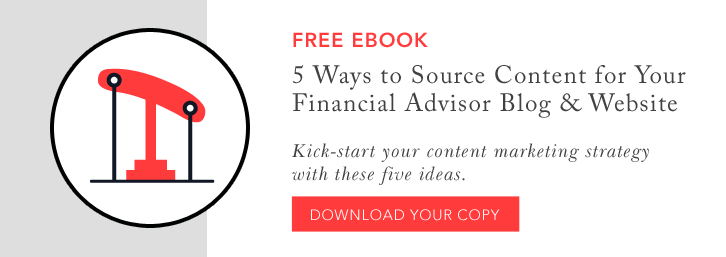5 Tips on How to Repurpose Your Financial Advisor Website Content
As a financial advisor, you know how important it is to engage with people who do not know your firm. Let’s call them strangers. They have to be able to find you on the Internet to engage with your firm. Therefore, Internet visibility is critical and writing top quality content is the best way to create that visibility.
You have a couple of choices when it comes to content. You can write all new content or you can repurpose content you have already written and published. When your financial advisor content marketing strategy creates a great article that performs exceptionally well and resonates with your target audience, you want to get the most out of it that you can.
This could be because you don’t have time to write new content or you do not view writing financial advisor content as the highest and best use of your time. Or, it may be because you want to get more miles out of something that worked really well the first time. But sharing the exact same content – no matter how successful it was the first time – may not be the best way to gain more visibility with strangers.
The good news is, you don’t have to reinvent the wheel. Good content is always good content – and sometimes it just needs a little bit of a refresher to make it work in multiple different channels over longer periods of time. Think about all of the great content you have produced – no matter the channel (direct mail, blog, website, webinar, etc.) and read on for ways you can repurpose it to get even more from it:
1. Refresh and Update it
The best thing about good content is that with few exceptions, good content is always going to be good content. But that doesn’t always mean it will perform well at any given time/channel. If you’re going to repurpose it, you need to check for a few things first. No use wasting your time if the efforts are not going to reach more strangers.
The first criterion is timeliness. Is the content still current and relevant? Does it mention any specific dates or public events/news references? These are things that can change very fast and scanning the content for any of those citations can go a long way toward avoiding any dating of your new content.
Next, is the content still relevant? Perhaps what was a really hot topic a year or even a few months ago has taken a back seat to something even newer and more relevant. Go through the content with a fine-tooth comb and check for anything that needs updating. While this may take a bit of work, you will still have gained a basically “updated” piece of content that you can add to your blog or website.
Another tip: If you had help – say a co-author or someone you interviewed – check with them to make sure their contact information is the same. Names change, titles change, people change jobs and so on, and you don’t want to publish inaccurate information if you can avoid it. The same goes for any online sources you may have cited in your original content. Make sure any links you provided are still going to live pages, and make sure the content you cited is still referenced there.
2. Make it a Blog Article
You already know the importance of having a blog tied to your website. Blogging is the best way to share content. And that includes repurposed content!
Repurposing content into blog articles is one of the easiest ways to streamline your efforts and get your content in front of a new strangers. Blog posts are typically shorter, ranging from 600 to no more than 1,200 words. If you have some long content such as a study, report or guide, you can turn that into a series of blog posts with each focusing on a specific part of the original content. This series can be shared over the course of several weeks, refreshed, and then shared again for another round. In this case you can turn one original piece of content into several shorter pieces of content with minimal effort. This will also establish you as an authority on that subject matter, and keep people coming back to read more of your content.
3. Make it an Infographic
Turning content into an infographic is another way to repurpose your content. An infographic is simply an online image that depicts information, usually through the use of icons, and other colorful graphics.
Using an infographic can work especially well with content that can get very heavy and bogged down with facts and figures, but is still really good, relevant content. If you take that data and turn it into something that is easily digested by the average non-financial expert, you have created a highly shareable piece of content that you can use over and over again, including on social media posts. Also, one of the best things about infographics is that they can also be a lead generation tool. People will often give-up their contact information to download the infographic, sign up for email newsletters, etc.
4. eBook
An eBook is a great marketing tool for financial advisors. An eBook is an opportunity to capture contact data in return for information that the investor is curious about. Ebook’s aren’t books, the name is just a fancy way of describing a report or guide that is published online. eBooks can be another useful way to repurpose existing content. And don’t worry – it doesn’t really need to be the length of a book - 1500 to 2000 words is enough.
Instead of starting from scratch, you can create a “top hits” version of all of your best content and wrap it into an eBook. You can even include infographics and images to break up the content. Once it’s ready for download, don’t forget to put it behind a lead generation form as you did with infographics so you don’t miss opportunities to reach out to investors who want to read your new content.
5. Podcast
Yes, a podcast. And no, it doesn’t have to be like the ultra-professional, polished serialized podcasts you may listen to for work or pleasure. A podcast, by definition, is a recording made available for streaming services. And, you don’t have to be famous or all that technically savvy to record, produce and publish a podcast.
Will you make it to the top of the podcast charts? Probably not – but that’s not the point. The point is to take content you know works, refresh it, and appeal to a different audience. While some people may never choose to read your blog, they may learn better through audio and choose to listen to your podcast on the same topic.
One of the major benefits of podcasting is that people can listen while they’re doing other things. Some people listen during their daily commute, others at the gym or on a walk, and some may even listen while at work to drown out the general office noise clutter. The bottom line is with a recorder, smartphone and access to the internet you can become a podcaster.
Now that you understand the basics of re-purposing content, let’s get started! The content marketing experts at Paladin Digital Marketing know what it takes to create a successful content marketing strategy and will work with you every step of the way. Contact us today.


